Industrialisation
Industrialisation (UK) or industrialization (US) is the period of social and economic change that transforms a human group from an agrarian society into an industrial society. This involves an extensive reorganization of an economy for the purpose of manufacturing.[3] Industrialization is associated with increase of polluting industries heavily dependent on fossil fuels. With the increasing focus on sustainable development and green industrial policy practices, industrialization increasingly includes technological leapfrogging, with direct investment in more advanced, cleaner technologies.

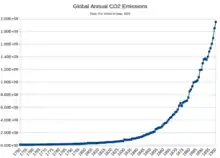
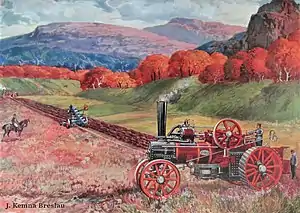
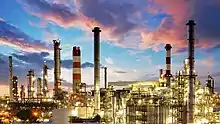
The reorganization of the economy has many unintended consequences both economically and socially. As industrial workers' incomes rise, markets for consumer goods and services of all kinds tend to expand and provide a further stimulus to industrial investment and economic growth. Moreover, family structures tend to shift as extended families tend to no longer live together in one household, location or place.
Background
The first transformation from an agricultural to an industrial economy is known as the Industrial Revolution and took place from the mid-18th to early 19th century. It began in Great Britain, spreading to Belgium, Switzerland, Germany, and France and eventually to other areas in Europe and North America.[4] Characteristics of this early industrialization were technological progress, a shift from rural work to industrial labor, and financial investments in new industrial structures.[5] Later commentators have called this the First Industrial Revolution.[6]
The "Second Industrial Revolution" labels the later changes that came about in the mid-19th century after the refinement of the steam engine, the invention of the internal combustion engine, the harnessing of electricity and the construction of canals, railways, and electric-power lines. The invention of the assembly line gave this phase a boost. Coal mines, steelworks, and textile factories replaced homes as the place of work.[7][8][9]
By the end of the 20th century, East Asia had become one of the most recently industrialized regions of the world.[10] The BRICS states (Brazil, Russia, India, China, and South Africa) are undergoing the process of industrialization.
There is considerable literature on the factors facilitating industrial modernization and enterprise development.[11]
Social consequences
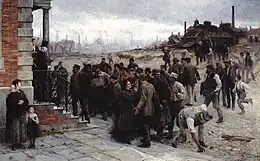
The Industrial Revolution was accompanied by significant changes in the social structure, the main change being a transition from farm work to factory-related activities.[12] This has resulted in the concept of Social class, i.e., hierarchical social status defined by an individual's economic power. It has changed the family system as most people moved into cities, with extended family living apart becoming more common. The movement into more dense urban areas from less dense agricultural areas has consequently increased the transmission of diseases. The place of women in society has shifted from primary caregivers to breadwinners, thus reducing the number of children per household. Furthermore, industrialisation contributed to increased cases of child labor and thereafter education systems.[13]
Urbanisation

As the Industrial Revolution was a shift from the agrarian society, people migrated from villages in search of jobs to places where factories were established. This shifting of rural people led to urbanization and an increase in the population of towns. The concentration of labor in factories has increased urbanization and the size of settlements, to serve and house the factory workers.
Exploitation
Changes in family structure
Family structure changes with industrialization. Sociologist Talcott Parsons noted that in pre-industrial societies there is an extended family structure spanning many generations who probably remained in the same location for generations. In industrialized societies the nuclear family, consisting of only parents and their growing children, predominates. Families and children reaching adulthood are more mobile and tend to relocate to where jobs exist. Extended family bonds become more tenuous.[14]
Industrialisation in East Asia
Between the early 1960s and 1990s, the Four Asian Tigers underwent rapid industrialization and maintained exceptionally high growth rates.[15]
Current situation
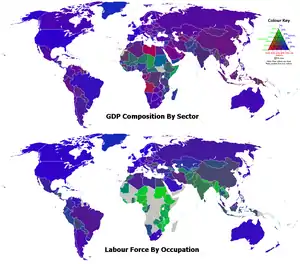
As of 2018 the international development community (World Bank, Organisation for Economic Co-operation and Development (OECD), many United Nations departments, FAO WHO ILO and UNESCO,[16] endorses development policies like water purification or primary education and co-operation amongst third world communities.[17] Some members of the economic communities do not consider contemporary industrialisation policies as being adequate to the global south (Third World countries) or beneficial in the longer term, with the perception that they may only create inefficient local industries unable to compete in the free-trade dominated political order which industrialisation has fostered. Environmentalism and Green politics may represent more visceral reactions to industrial growth. Nevertheless, repeated examples in history of apparently successful industrialisation (Britain, Soviet Union, South Korea, China, etc.) may make conventional industrialisation seem like an attractive or even natural path forward, especially as populations grow, consumerist expectations rise and agricultural opportunities diminish.
The relationships among economic growth, employment, and poverty reduction are complex. Higher productivity, it is argued, may lead to lower employment (see jobless recovery).[18] There are differences across sectors, whereby manufacturing is less able than the tertiary sector to accommodate both increased productivity and employment opportunities; more than 40% of the world's employees are "working poor", whose incomes fail to keep themselves and their families above the $2-a-day poverty line.[18] There is also a phenomenon of deindustrialisation, as in the former USSR countries' transition to market economies, and the agriculture sector is often the key sector in absorbing the resultant unemployment.[18]
See also
References
- Bairoch, Paul (1995). Economics and World History: Myths and Paradoxes. University of Chicago Press. p. 95. ISBN 978-0-226-03463-8. Archived from the original on 27 September 2022. Retrieved 7 July 2021.
- https://ourworldindata.org/grapher/annual-co2-emissions-per-country?time=1750..1900&country=~OWID_WRL
- O'Sullivan, Arthur; Sheffrin, Steven M. (2003). Economics: Principles in Action. Upper Saddle River, New Jersey 07458: Pearson Prentice Hall. p. 472. ISBN 0-13-063085-3. OCLC 50237774.
{{cite book}}: CS1 maint: location (link) - Griffin, Emma, A Short History of the British Industrial Revolution. In 1850 over 50 percent of the British lived and worked in cities. London: Palgrave (2010)
- Sampath, Padmashree Gehl (2016). "Sustainable Industrialization in Africa: Toward a New Development Agenda". Sustainable Industrialization in Africa. Springer. p. 6. doi:10.1007/978-1-137-56112-1_1. ISBN 978-1-349-57360-8.
Contemporary notions of industrialization can be traced back to the experience of Great Britain, Western Europe and North America during the 19th and early 20th centuries (Nzau, 2010). The literature that reviews the experiences of these countries seems to agree that, although the early-industrializing countries started at different stages of growth, they followed more or less a similar format of change that led to their transformation. Marked by the shift from a subsistence/agrarian economy to more industrialized/mechanized modes of production, hallmarks of industrialization include technological advance, widespread investments into industrial infrastructure, and a dynamic movement of labor from agriculture into manufacturing (Lewis, 1978; Todaro, 1989; Rapley, 1994).
- Pollard, Sidney: Peaceful Conquest. The Industrialisation of Europe 1760–1970, Oxford 1981.
- Buchheim, Christoph: Industrielle Revolutionen. Langfristige Wirtschaftsentwicklung in Großbritannien, Europa und in Übersee, München 1994, S. 11-104.
- Jones, Eric: The European Miracle: Environments, Economics and Geopolitics in the History of Europe and Asia, 3. ed. Cambridge 2003.
- Henning, Friedrich-Wilhelm: Die Industrialisierung in Deutschland 1800 bis 1914, 9. Aufl., Paderborn/München/Wien/Zürich 1995, S. 15-279.
- Industry & Enterprise: A International Survey Of Modernisation & Development, ISM/Google Books, revised 2nd edition, 2003. ISBN 978-0-906321-27-0. Archived 11 May 2016 at the Wayback Machine
- Lewis F. Abbott, Theories Of Industrial Modernisation & Enterprise Development: A Review, ISM/Google Books, revised 2nd edition, 2003. ISBN 978-0-906321-26-3.
- revolution, social. "social effects of industrial revolution". Archived from the original on 17 March 2012. Retrieved 1 April 2021.
- revolution, social. "social effect of industrial revolution".
- The effect of industrialisation on the family, Talcott Parsons, the isolated nuclear family Archived 20 November 2010 at the Wayback Machine Black's Academy. Educational Database. Accessed April 2008.
- "Four Asian Tigers". Corporate Finance Institute. Retrieved 27 January 2023.
- Child, development. "development and the whole child" (PDF). Archived (PDF) from the original on 17 January 2021. Retrieved 23 September 2020.
- United Nations Millennium Development Goals https://www.un.org/millenniumgoals/ / Archived 4 May 2007 at the Wayback Machine. Un.org (2008-05-20). Retrieved on 2013-07-29.
- Claire Melamed, Renate Hartwig and Ursula Grant 2011. Jobs, growth and poverty: what do we know, what don't we know, what should we know? Archived 20 May 2011 at the Wayback Machine London: Overseas Development Institute
Further reading
- Chandler Jr., Alfred D. (1993). The Visible Hand: The Management Revolution in American Business. Belknap Press of Harvard University Press. ISBN 978-0674940529.
- Hewitt, T., Johnson, H. and Wield, D. (Eds) (1992) industrialisation and Development, Oxford University Press: Oxford.
- Hobsbawm, Eric (1962): The Age of Revolution. Abacus.
- Kemp, Tom (1993) Historical Patterns of Industrialisation, Longman: London. ISBN 0-582-09547-6
- Kiely, R (1998) industrialisation and Development: A comparative analysis, UCL Press:London.
- Landes, David. S. (1969). The Unbound Prometheus: Technological Change and Industrial Development in Western Europe from 1750 to the Present. Cambridge, New York: Press Syndicate of the University of Cambridge. ISBN 0-521-09418-6.
- Pomeranz, Ken (2001)The Great Divergence: China, Europe and the Making of the Modern World Economy (Princeton Economic History of the Western World) by (Princeton University Press; New Ed edition, 2001)
- Tilly, Richard H.: Industrialization as an Historical Process, European History Online, Main: Institute of European History, 2010, retrieved: 29 February 2011.
